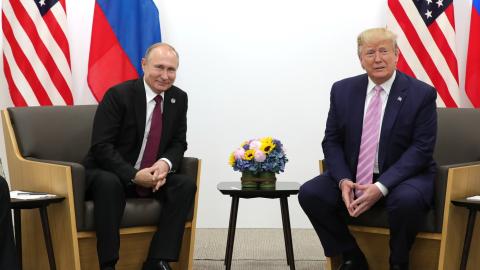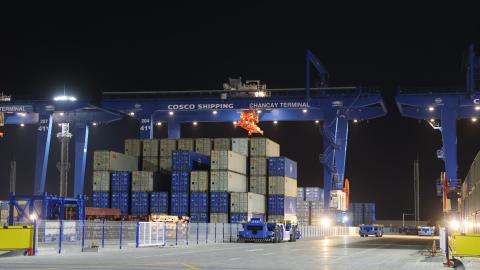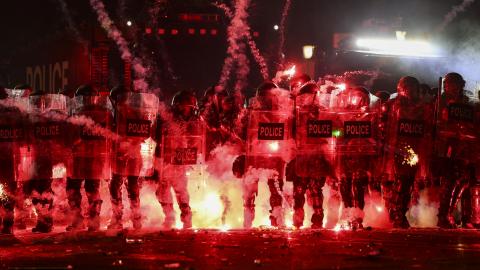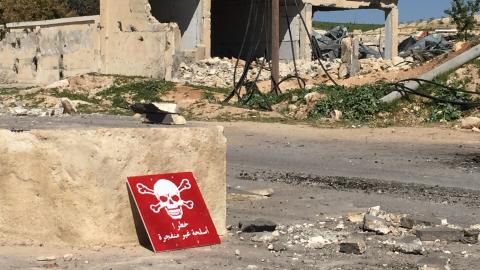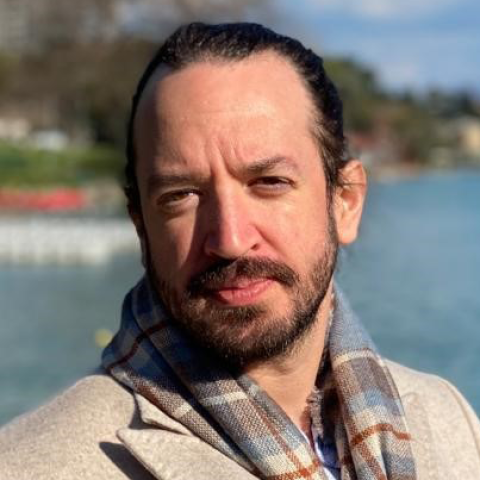The year preceding Pakistan's February 2008 general elections was one of the most tumultuous in the country's history. Along with the political upheavals associated with the judicial crisis, the military government's suspension of the constitution and imposition of emergency rule, and the assassination of Benazir Bhutto, the year brought with it an upsurge in violence following the Pakistan Army's siege of the radical Lal Masjid (Red Mosque) in the capital city of Islamabad. More than any other event in recent years, the Lal Masjid crisis led to an important new debate amongst the country's various religio-political movements over the legitimacy and efficacy of vigilante Islamism—that is, over the permissibility of a non-state actor to take unilateral action, through violence if necessary, to enforce the sharia apart from the hand of the state. This debate is likely to have continuing implications for Pakistan's internal stability, as well as the future shape of its Islamist discourse.
Pakistan is home to a wide array of Islamist actors and movements, nearly all of which have a stake in this discussion about vigilantism. These actors fall roughly along a spectrum that extends from mainstream, right-of-center parties which place a strong emphasis on the role of religion in politics, such as Nawaz Sharif's Pakistan Muslim League (PML-N); to expressly Islamist parties such as the Jamaat-e-Islami (JI); to localized insurgent movements in the tribal areas; and ultimately to transnational movements such as al-Qaeda. While these disparate groups often seem to profess the same generalized set of grievances in their respective struggles with state authority, they have pursued starkly different agendas, adhering to widely divergent conceptions about Islamization's desired objectives and the proper methods for achieving them.
Among the groups at the "peripheries" of this spectrum, attitudes toward vigilantism are relatively well-defined, and very much at odds: Mainstream parties like the PML-N clearly reject vigilantism in favor of Islamic reform through engagement in electoral politics, whereas groups like al-Qaeda embrace violent jihad, rejecting modern politics and the authority of the state as un-Islamic. But as important as the competition between these peripheries may be to shaping Islamist discourse overall, it is the religious parties and localized insurgent movements that occupy the middle part of the spectrum which are today driving the most important debates regarding Islamic political norms within Pakistan. While parties like the PML-N are clearly invested in electoral politics in their efforts to reform the state, and while al-Qaeda terrorists reject politics and are clearly striving to overturn the state, Pakistan's leading religious parties—most notably, the Jamaat-e-Islami (JI) and the Deobandi Jamiat Ulema-e-Islam (JUI)—have attempted to walk a fine line between the embrace of politics and the embrace of anti-state violence.
On one hand, parties like the JI and the JUI-F have ideologically and operationally supported vigilante activities in pursuit of a variety of Islamist causes. In some instances, these parties are able to provide real financial and human capital to militant groups, and they have sometimes sought to employ these groups to achieve their own political ends in their struggles to reform the state according to their party objectives. Simultaneously, these parties have for decades embraced politics; until recently, they were party to the Muttahida Majlis-e-Amal (MMA) coalition that governed the restive North-West Frontier Province (NWFP). As political actors, these parties have used their power to shape public discourse and perceptions regarding vigilante activities and insurgent groups—sometimes championing their causes. The fact that these parties engage in both vigilante activities and formal politics has contributed significantly to one of the more worrisome dynamics of post-9/11 Pakistan: the blurring of the line that should demarcate the realm of formal politics from anti-state violence.
At the same time, the issue of vigilantism—including its legitimacy and efficacy in promoting Islamic reform—remains a hotly disputed topic within religious parties like the JI and the JUI. These parties have with some success positioned themselves as key "swing votes" in the state's ongoing competition with religiously-oriented insurgencies such as that of the neo-Taliban. In this context, the issue of vigilantism represents a crucial ideological boundary marker, clarifying the increasingly blurred line between formal persuasive politics and a compulsive politics of insurgency.1 By exploring the responses of the JI and JUI to the dramatic events of the Lal Masjid in the summer of 2007, the following review seeks to shed light on factors that cause religious parties to traverse this critical line and reject state authority.
Religious Parties and Vigilante Islamization
There are two leading blocs of "democratic Islamist" actors in Pakistan. The first are the Deobandis, who trace their roots to the revivalist and educational movement that emerged from the Dar-ul Uloom at Deoband (a madrasa located in modern-day Uttar Pradesh, India) following the failed Indian uprising against the British in 1857.2 In 1919, a group of politically active Deobandis formed the Jamiat Ulema-e-Hind (Assembly of Indian Clerics) in India, which, after the 1947 partition of the subcontinent, produced a Pakistani branch known as the Jamiat Ulema-e-Islam (Assembly of Islamic Clerics). Like most Pakistani parties, the JUI has had a fractious history; today, the dominant faction, known as the JUI-F, is led by Maulana Fazlur Rahman and is predominantly ethnically Pashtun in composition.3 The JUI-F's religio-political agenda exhibits a sort of syncretism between conservative Deobandi religious values and the traditional Pashtun social code known as Pashtunwali. Its constituent base is located in the rural and largely Pashtun areas of the North-West Frontier Province and its active membership are largely drawn from the clerical religious class. While the JUI has attempted to portray itself since Pakistan's founding as a strictly political movement, it has also cultivated a host of informal connections with insurgent groups focused on the Kashmir struggle as well as the Afghan-Pakistan border.4 In fact, it was from the JUI's network of madaris that the original Taliban leadership emerged in the mid-1990s.5
The second major bloc of democratic Islamists is the Jamaat-e-Islami (JI), a movement whose origins, like the Deobandis', also predates the formal establishment of Pakistan. Founded by Maulana Abul Ala Mawdudi in 1941, the JI movement is distinctively modernist in its organization and ideology, recruits technocrats rather than clerics into its ranks, and draws its support predominantly from the "devout middle classes" of Pakistan's urban centers.6 The JI emphasizes reforming the state and the legal apparatus along Islamic lines. Its focus on political transformation is, in important ways, akin to the ideas of Arab Muslim Brotherhood intellectuals such as Hassan al-Banna and Said Qutb.7 The party has a long history of advocating for the implementation of the sharia into virtually every arena of Pakistani political and civic life, from law to banking to education. Unlike the JUI-F and other Deobandi groups, which have developed a diffuse organizational structure in keeping with its diffuse network of madaris, the JI is known for its unusually strict party discipline and pursues its agenda with centralized bureaucratic efficiency.8
Throughout Pakistan's history, elements within both the JUI and JI have shown an opportunistic willingness to take up vigilante action in pursuit of Islamization. Given the different organizational structures and ideological orientations of these groups, however, the level and focus of their involvement in vigilantism has been quite different.
The Deobandi JUI-F has generally taken a less direct approach than the JI in its pursuit of Islamization. The JUI-F as a whole tends to be loosely managed, with its organizational center of gravity in the Deobandi madrasa networks rather than within a formal bureaucratic apparatus. As such, vigilantism usually has not been sanctioned at the highest levels by established Deobandi scholars; it has emerged from local madrasa-based groups. The JUI-F's signature contribution to extra-legal Islamization has been its indirect support of militant Deobandi groups. It is widely acknowledged, for instance, that some Deobandi clerics open their madaris to recruitment by violent sectarian (i.e., anti-Shia, anti-Barelvi, and anti-Ahmadi9) organizations such as Sipah-e-Sahaba (an offspring of the JUI), as well as to anti-Western insurgent groups such as the Pakistani neo-Taliban.10 Because of overlap in membership in the JUI-F and various insurgent groups—particularly at the level of junior operatives—the party has been able to indirectly engage in vigilante activities, allowing its elites to retain a measure of plausible deniability. It is suspected, for example, that some of the Taliban "night letters," which in 2007 threatened the Christian minority in Charsadda, NWFP, were planted by a local JUI-affiliated cleric, perhaps with the support of lower-level Taliban operatives from outside the district. Meanwhile, in the heartland of central Punjab, several prominent JUI leaders are openly known to have direct ties to anti-Shia groups.11
In recent years, the JI has been more visibly involved in vigilante activities than the JUI. From 2002-2007, when the provincial government in NWFP was led by the Muttahida Majlis-e-Amal (MMA), a coalition of six Islamic parties dominated by the JUI-F and the JI, the JI was reported to have undertaken a coordinated campaign against what it deemed as "vulgarity" in and around the frontier's capital of Peshawar. This campaign included tearing down billboards that displayed women's faces, threatening music stores, and destroying cable television transmission equipment. In mid-2003, these vigilante activities of the JI's youth wing Shabab-e-Milli were so egregious that Islamabad recalled two senior officials from the NWFP government for failing to deal with the situation.12 For many years, the JI has also been implicated in vigilantism in other parts of parts of Pakistan, most notably in Punjab province, where it has threatened mixed-gender marathons and attacked movie theaters.13
The JI's inclination to participate in vigilantism can be explained by several factors. In part, it may be due to the fact that JI's base is a predominantly urban one, and that the population density in urban areas is likely to make urban vigilante agitation more attractive and politically effective than in rural settings. The Jamaat's vigilantism must also be seen, however, in light of the entrenched historical and organizational biases of the party. The JI's student wing, the Islami Jamiat-e-Talaba (IJT), has a long history of organized vigilantism on college campuses. Several of the senior Jamaat politicians who now lead the party once operated as de facto mob leaders at public universities in Lahore and Peshawar, where they were groomed for JI leadership posts. IJT cadres regularly disrupt mixed-gender gatherings at universities, sometimes violently. They have come to dominate so completely the campus of Lahore's Punjab University that administrators have been practically helpless to reassert control.14
In many ways, the JUI-F's and the JI's attitudes toward vigilantism are shaped by their basic religious and ideological perspectives. Broadly speaking, the JUI-F ideology of Islamization is less radically revisionist than that of the JI. Since its early days, the JI has articulated a comprehensive vision of reformulating the state along Islamist lines, and considers extra-legal confrontation to be a vital part of that broader struggle to reform society.
The JUI-F, by contrast, has sought a process of Islamization that fuses Muslim religious identity with traditional Pashtun tribal values. Although JUI-F leaders enthusiastically supported the efforts of the first-generation Taliban in the mid-1990s, the party's leadership has shown little interest in replicating within Pakistan itself the more revolutionary social or political aspects of Mullah Omar's stark Islamist vision.15 Remarkably, the JUI-F has been by and large oriented toward the preservation of the status-quo. Political rhetoric aside, its posture has been consistently attuned to reinforcing conservative social norms. It has also sought state patronage for (or at the very least, resisted state oversight of) Deobandi madrasa networks. Thus the party leaders have tended to outsource to local actors the more confrontational aspects of their struggle. This allows them to maintain deniability while continuing to cultivate their relationship with state authority.16
Lal Masjid: Allies and Antagonists
While the events surrounding the Lal Masjid in the summer of 2007 catalyzed debate within the JI and the JUI-F over the legitimacy of vigilantism, the mosque itself had not always been a symbol of anti-state agitation. In the 1980s, Lal Masjid's former head, Maulana Muhammad Abdullah, was the beneficiary of President Zia ul-Haq's program of state-directed Islamization. He also developed close ties to the Inter-Services Intelligence (ISI) bureaucracy headquartered nearby.17 Following Abdullah's assassination in 1998, his sons Abdul Aziz and Abdul Rashid Ghazi assumed control of the mosque. Affiliated with the mosque were male and female madaris —the Jamia Faridia and Jamia Hafsa, respectively—which drew a large number of students from the Pakistani frontier.
The crisis was triggered by a series of provocations by the madrasa students that included a campaign protesting the demolition of an illegally constructed mosque in Islamabad; the takeover of a nearby children's library by heavily-armed female students; the kidnapping of alleged prostitutes from a Chinese acupuncture clinic; the abduction of police officers; the attacking of music shops; the stockpiling of weapons; and the burning of a nearby government building.18 In addition, Abdul Aziz Ghazi established a parallel qazi court in Islamabad and soon thereafter began issuing fatwas against local purveyors of vulgarity, including a female federal minister whom he accused of obscenity for being photographed hugging a paragliding instructor in Paris.19
In short, the Ghazi brothers decided that if the state would not act against public "indecency," they would do so themselves. Their intentions seemed, to begin with, limited in scope. As Faisal Devji has noted, "their kidnappings and forcible closing of immoral businesses were attempts to court publicity that resulted not so much in the meting out of any Islamic punishments as in the almost Maoist "re-education' and subsequent release of alleged prostitutes."20 Gradually, however, the Lal Masjid leaders lost confidence in the state to carry out their vision of an Islamic reformation. The Ghazi brothers had retained close linkages to the Taliban and to experienced militant groups like the Jaish-e-Muhammad. Combined with the Ghazis' own self-amplified cult of martyrdom, these ties ultimately resulted in a full-scale confrontation with the state.21
Eventually, the state lost confidence in the Ghazi brothers. After negotiations had dragged on for several months, the government acted in early July, seizing the mosque and madaris in an effective but bloody army operation in which Abdul Rashid Ghazi and hundreds of students were killed.22 In reaction to the army's siege, which was dubbed "Operation Silence," a wave of protests and suicide bombings was unleashed that continued throughout the summer and fall of 2007.
The involvement of the JI and Deobandi religious parties in the lead up to and during the Lal Masjid crisis is complex and, to this day, not entirely clear. In early 2007, as the Jamia Hafsa students began their vigilante campaign in Islamabad, both the JI and the JUI-F responded to these vigilante provocations in somewhat the same manner. They both affirmed the general goals of the movement's Islamist agenda. They counseled the state to negotiate with the activists, and blamed the government for targeting Islamic madaris and seeking their reform in order to curry favor with the West. At the same time, the JI and JUI-F leaders criticized the students for attacking local houses (such as massage parlors), noting that "such things [are] not allowed in civil society" and that only the state had the authority to determine which citizen to apprehend for which crime.23
Soon thereafter, however, the JI's leadership began to qualify its criticism of the students. Knowing that taking a harsh stand against burqa-clad, sharia-promoting female students would likely prove unpopular among the rank-and-file, one JI spokesman declared that his objection was not simply to the students' actions as such. His objection, instead, was that the vigilante campaign against vulgarity was being led by women —which (he claimed) was clearly forbidden by Islam.24
It was not long before the official JI and JUI-F positions regarding the madrasa -based vigilantism began to diverge. By mid-April, the JI's Amir, Qazi Hussain Ahmed, had begun to come out more forcefully in favor of the Jamia Hafsa. Although he reiterated that "the MMA does not want to implement sharia by force," he described the Ghazi brother's new qazi court a "positive" step and lent his support to the Lal Masjid's administration.25 The JUI-F, by contrast, was more reserved about endorsing the Ghazi brothers. While blaming the intelligence agencies for fomenting conspiracies to create "a pretext for taking... action against seminaries across the country," the JUI-F also urged the Lal Masjid's administration to avoid being manipulated by the state.26
In hindsight, it appears that this statement from JUI-F was meant to signal to the Lal Masjid that the party did not approve of its actions, and would not agree to agitate on its behalf. In fact, as the crisis unfolded, the JUI-F's close associates within the Deobandi madrasa community openly began calling for greater restraint, particularly on the part of Jamia Hafsa. In April, many of the leaders of the Wafaq-ul-Madaris al-Arabia, the leading Deobandi madrasa board in Pakistan, voiced concerns over the escalation of vigilante violence from the Jamia Hafsa. The Wafaq-ul-Madaris then took the highly unusual further step of revoking the madrasa's certification. The board's secretary general, Qari Hanif Jalandhri, tried to insert himself as a mediator in the talks between Abdul Aziz Ghazi and the Pakistan government.27 Jalandhri emphasized the Deobandi leadership's delicately balanced position, arguing that, "We are against a policy of taking on the government in a head-on fight, as such a policy can only lead to damage," but noting in the next breath that he supported Abdul Aziz's demands "one-hundred-and-one percent."28 Another leading Deobandi cleric, Mufti Rafi Usmani, tried a similar balancing act: "We should continue the struggle that they have started... [but their path] leads to violence and fighting, which we do not at all condone or permit."29
The JUI-F's ambivalence about the Jamia Hafsa took many observers by surprise. After all, as one up-and-coming JUI-F politician put it, "the madaris are our number one priority," and many expected that this meant the party would strive to defend the Lal Masjid.30 But as it turned out, the Deobandis were making a second, parallel political calculation: they were afraid that one high-profile case of vigilantism-turned-violent would tarnish the reputation of Deobandi madaris throughout the country. Much of this fear was articulated by the Wafaq-ul-Madaris' leadership, along with former politicians such as the esteemed Maulana Hassan Jan in Peshawar, rather than by JUI-F officials.31 Interviews in Islamabad and Peshawar with party leaders in the summer of 2007 confirmed that the position of Wafaq-ul-Madaris leaders, like Jalandhri's, were in fact broadly representative of the party's own thinking, especially as it concerned the risks associated with appearing too supportive of the Ghazi brothers. As if reading from talking-points (a practice seemingly at odds with the otherwise chaotic nature of Deobandi politics), one party leader after another declared, "Ghazi's objective is right, but his path is wrong."
The JUI-F supported Islamization in Pakistan, but wanted to appear to do so only within the bounds of the formal political space. In addition to the party's preoccupation with protecting its madaris network, its position toward the Ghazi brothers was driven by other high-level political concerns. Five years after its founding, the MMA alliance was fraying, with the JI taking an uncompromising stance against President Pervez Musharraf, and the JUI-F pursuing a more conciliatory approach. This split, in turn, had its origin in a number of factors, including the varying political styles of the party's leadership, and the JUI-F's somewhat greater reliance on state patronage to perpetuate its political future. (The JI, perhaps due to its consistent middle-class urban support base, historically has been more willing to confront the government in power.)
But an even more specific trend drove the JUI-F to oppose Abdul Aziz's vigilante agenda. The party, in brief, appears to have concluded that support for the Lal Masjid administration might redound negatively on its own ability to carry out its governance agenda in the NWFP, where it was still the leading and most visible party of the MMA government. On the one hand, the JUI-F could not openly oppose the Jamia Hafsa's establishment of qazi courts, since the MMA itself had proposed a similar arrangement in its ill-fated Hisbah bill—a signature piece of provincial sharia legislation that had been blocked three times by the federal Supreme Court for being unconstitutional.32 On the other hand, the party was concerned that if it was seen as legitimizing vigilante Islamism against the federal government, it would have no credible reason for opposing those same activities perpetrated against its own government in the Frontier.
This was more than an academic concern. In April 2007, the Islamist government in Peshawar was dealing with a vigilante Islamist of its own—Maulana Yousaf Qureshi of the Muttahida Shariat Mahaz. Qureshi was threatening to close music shops and to launch a unilateral jihad against brothels in Peshawar. When faced with Islamist threats to the security of his own jurisdiction, the Peshawar district nazim (mayor) Haji Ghulam Ali, a son-in-law of Maulana Fazlur Rahman, argued, "I have to protect the legitimate and legal businesses of the people.... we cannot allow [Qureshi] to indulge in vigilantism."33 The JUI-F-affiliated Chief Minister of the NWFP similarly pleaded, "Some people are violating the law in the name of 'religious sentiment' because they want to topple my government. I ask these clerics: what they want to do through force — can it not be done through democracy?"
That of course was an eminently reasonable question to ask, but it was also one that could just as easily have been posed by President Musharraf's government in Islamabad to the leaders of the Jamia Hafsa. In addition to its desire to protect its madari networks and to secure state patronage, it was arguably the stake which the JUI-F held in the NWFP government—its stake in participatory governance—that encouraged it to moderate its position on the legitimacy of vigilantism.
The Crisis and Beyond
As the crisis came to a peak in early July, both parties began to recalibrate their language, emphasizing their support for the Lal Masjid movement. After a clash between madrasa students and police on July 3 which left several students dead, JI Amir Qazi Hussain declared the state "wholly responsible," and Maulana Fazlur Rahman of the JUI thundered that the government was playing a "game of blood and fire." 34
This rhetoric notwithstanding, the JUI-F was in practice quietly working to defuse the situation by assisting the central government as a go-between, with Chief Minister Akram Khan Durrani meeting clerics from the Wafaq-ul-Madaris, as well as representatives of the Ghazi brothers, at the secluded Frontier House in Islamabad.35 For a moment, it looked as though a compromise agreement might be reached: The Jamia Hafsa would be transferred to the control of the Wafaq-ul-Madaris, thus satisfying both government concerns in rolling back the Ghazi brothers as well as the Deobandis' concerns over state interference in the madrasa system. But the agreement soon fell apart—apparently for reasons of mutual inflexibility, as Jalandrhi has implied—and the Pakistani army proceeded with its siege of the Lal Masjid.36
By the time the dust settled, political realities had clearly begun to change, and the JUI-F did not waste much time further revising its earlier position. While in theory it remained opposed to the vigilantism of the Jamia Hafsa students, it was forced to distance itself from the government and it accede to the hagiographical narrative regarding the Lal Masjid that had was being promulgated by the JI and other Islamist groups. Abdul Rashid Ghazi, who was killed in the operation, was hailed as a shaheed (martyr) by the JI Amir Qazi Hussain, and Fazlur Rahman praised the Lal Masjid fighters as "mujahideen who fought for enforcing Islam in its true spirit."37
In a very real way, Operation Silence transformed the place of the Lal Masjid in the debate over vigilante Islamism. Gone was the symbol of Ghazis-as-vigilantes that had proved so vexing for the JUI-F. In its place emerged a picture of the Ghazis-as-martyrs that provided a much more potent symbolic weapon for the religious parties to use against the government.
On one level, Operation Silence came as a welcome relief for the JUI-F: The public's attention was diverted away from illicit activities of Deobandi madaris and toward the heavy-handed and widely condemned actions of the government. And if the Deobandis were relieved, the JI was ecstatic. Sensing a political opening against President Musharraf, the JI tacked heavily in support of the Lal Masjid movement, stoking public anger against the government's handling of the crisis. Unfortunately for the JI, the feeling was not entirely mutual. Prior to the army operations, the relationship between the Lal Masjid leadership and the JI had been mutually advantageous; the Ghazi brothers used the JI to amplify their political voice, and the Jamaat used the Lal Masjid crisis to impugn President Musharraf. But after the military intervention and the dead from Lal Masjid were hailed as martyrs, the JI found that it was no longer "needed" by the very movement that it was trying to defend and lionize.
Several weeks after Operation Silence, when the government attempted to re-open the Lal Masjid for Friday prayers, it again was confronted by mobs of young madrasa students. As police looked on, the students promptly re-took the mosque, hoisted the black flag of jihad, repainted the dome of the mosque a vibrant red, and yelled from the roof, "Ghazi, Ghazi, from your blood the revolution will come!"38 Perhaps most tellingly, when two senior members of the JI attempted to enter the mosque and lead prayers in Ghazi's honor, they were forcefully rebuffed by angry students, and pressed to retreat to the courtyard, where they prayed and then hosted a news conference.
It was a stirring scene, not only for the JI's political theatrics, but because it threw into relief the boundary line separating the legitimate political sphere and the realm of anti-state activity. The JI, after trying to defend and champion the Lal Masjid movement for its own political gain, found itself unexpectedly and forcefully rebuffed by the Lal Masjid movement; it was no longer operating within its preferred terms of reference. (The students, for their part, argued that the JI was simply trying to gain political mileage on their behalf, and had not fully supported the agenda of the Ghazi brothers.) It was a moment in which both groups appeared to recognize that there exists only a narrow political window in which vigilantism can serve both electoral and insurgent ends, and that that window had closed.
The Deobandi political leadership faced its own conundrum in the wake of Operation Silence and was forced to confront deep internal rifts over its relationship to vigilante groups. These rifts erupted into view during the Wafaq-ul-Madaris meetings in early August 2007.39 The madaris board was split. Some, like JUI-F leader Maulana Fazlur Rahman and Qari Hanif Jalandhry, wanted to downplay the Lal Masjid issue. Others, like Maulana Sami-ul Haq of the JUI-S and JUI-F politician Hafiz Hussein Ahmed from Balochistan, wanted to launch a mass protest against the Lal Masjid operation and agitate in support of Maulana Abdul Aziz, who was by that time in government custody.40
In one respect, the JUI-F's position on Lal Masjid turned out to be precisely the inverse of the JI's. The JI leadership, by supporting the Jamia Hafsa, was testing the limits of religious party support for insurgent action against the state. The JUI-F, by contrast, seemed to be actively testing the limits of religious party rejection of vigilantism—that is, the degree to which religious parties might be able to disassociate themselves from madrasa-students who take the law into their own hands. By not aggressively throwing his support behind the actions of the Ghazi brothers, it appears that Maulana Fazlur Rahman risked exposing himself and his party to attacks from other Islamist groups as well as to internal dissent. Indeed, press reports suggest that the Deobandi Wafaq-ul-Madaris received threats from a Taliban leader in the South Waziristan tribal agency (most likely from the insurgent leader Baitullah Mehsud) warning of severe punishments if the board continued to "compromise with the government."41 The meeting of the Wafaq in early August was itself so contentious on this point that when one JUI-F senator criticized the Lal Masjid administration, reports claimed that he was "thrashed by enraged clerics amid calls for his death."42
Patterns of Islamist Interaction
The response of the JI and the JUI-F to the Lal Masjid crisis is in some ways a microcosm of the ways in which religious actors in Pakistan's formal political space are forced to interact with insurgent vigilante groups. The parties' responses to the crisis reveal that these interactions occur along three important vectors. First, at a structural level, it is clear that both religious parties and insurgent groups often profess very similar goals, such as the enactment of a vaguely specified sharia. However, continual competition drives them to manipulate each other to gain advantage vis-à-vis third parties. Religious parties seek to use insurgent movements to gain leverage over the state (e.g., the JI's use of the Lal Masjid as a platform to oppose Musharraf), and also seek to use the state to consolidate influence over these same movements (e.g., the JUI-F's attempt to convince the government to bring the Jamia Hafsa under the management of the Wafaq-ul-Madaris). Insurgent groups, in turn, may use religious parties indirectly to influence state behavior (e.g., the Ghazi brothers welcoming Qazi Hussain Ahmad to the Jamia Hafsa to lend credibility to their demands), or try to convince the state to bypass the religious parties and instead confer legitimacy on a new generation of religious leaders (e.g., a process which has arguably taken place with the Taliban's negotiations with the state in Waziristan and Swat).43 Religious parties are, moreover, quite vulnerable to state pressure, and have to operate in a macro political environment in which support for vigilantism may result in attempts by the state to circumscribe their electoral agenda.44
Second, at a systemic level, religious parties are aware that they operate within a closed system, and that their support for particular forms of vigilantism have a precedent-setting function that may prove detrimental to their future success in the formal political space. More specifically, parties like the JUI-F which seek to benefit from the state patronage afforded to them as "insiders" are likely to be wary of indirectly legitimizing groups like the Taliban or the Lal Masjid clerics for fear of eroding their own constituent base. While neither the JI nor the JUI-F face a zero-sum politics with respect to these other groups, their recruiting pools are indeed limited and relatively inelastic. This is especially the case for the JUI-F, which draws heavily from ethnic Pashtun areas and competes with a spectrum of more radical Islamist groups for madrassa students as well as entry-level political operatives.
Third, the parties' responses to vigilante Islamism are shaped by their respective ideological orientations and organizational roots. Though it would not admit it, the JI is statist in orientation and disposed toward challenging the state structure on its own terms. Its predominantly urban constituency and tightly managed organizational structure facilitate focused acts of protest against the state. (In fact, the party, lacking a secure ethnic base, engages in these protests in order to set itself apart from its electoral rival the PML-N.) And in spite of its bureaucratic cohesiveness, it has grown adept at segmenting the activity of its youth and student wings from the main party apparatus so as to gain some measure of plausible deniability for vigilante activities. The JUI-F, by contrast, is both more organizationally diffuse than the JI, and more concerned with protecting its madrasa networks than forcing the hand of the state in areas of public morality. Direct participation in vigilantism militates against the party's desire to be seen — both within Pakistan and abroad — as legitimate, mainstream political actors. To the extent that vigilantism has utility for the JUI-F, it most effectively serves their purposes when it is quietly outsourced to insurgent or sectarian groups.
If there is a lesson to be found in these patterns of Islamist response to the Lal Masjid crisis, it may be that the line between persuasive and compulsive Islamism is likely to remain blurred in Pakistan for some time. The emergence of new vigilante Islamist movements—such as that of the Ghazi brothers, and now the neo-Taliban operating throughout Pakistan's north-west frontier—puts new pressures on parties like the JI and the JUI-F to demonstrate that they too can provide decisive action to advance the cause of sharia. In such an environment, even subtle shifts in Islamist rhetoric about vigilantism can serve to illuminate the ways in which religious parties relate to state authority, and pursue their Islamization agenda.
In late July 2007, Qari Abdul Bais Siddiqui, a JUI-F member of the national assembly and long-time madrasa leader from the Swat valley, gave an interview regarding the crisis of the Lal Masjid. When asked about the vigilantism carried out by students of the Jamia Hafsa, he said, predictably, "I told Abdul Rashid Ghazi, 'you have the right objective, but your path is wrong.'" He then went on to offer a compelling analogy drawn from personal experience: "If," he said, "I ran a madrasa, and one of my students was caught stealing, the proper punishment is to cut off his hand." He paused. "But that is not for me to do. That is something for the state to do. There are conditions and procedures which must be followed."
Many observers would be troubled to hear a teacher state so matter-of-factly that his student would deserve so cruel a punishment. But situated within the context of Pakistan's debates over vigilantism, the Qari's comment can also be understood as implicitly accepting state authority. In spite of his reading of the Islamic tradition's views on just punishment, he was articulating a basic dividing line between his own agency as a religious and political leader and that of the state, suggesting that the latter has a legitimate monopoly over the use of violence. Such a distinction may not, by the standards of modern political principles, seem like the ideal marker by which to determine who constitutes a "moderate" or legitimate political voice. But in an environment of increased contestation between religious parties and Islamist insurgent movements, the Qari's distinction—unsatisfying as it might be—may indeed be the most important dividing line in Pakistan's shifting Islamist space, and will likely be a critical factor in determining whether Pakistan will be able to rein in vigilante violence.
__The author would like to thank Mariam Mufti, Haider Mullick, Hasan-Askari Rizvi, Nicholas Schmidle, Chris Seiple, Niloufer Siddiqui, and Daniel Simons for their helpful comments on an earlier draft of this article.__
